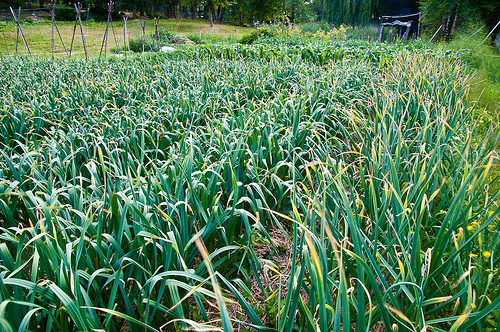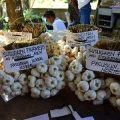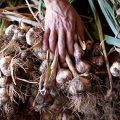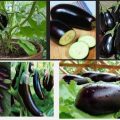Garlic (Allium stivum L.) or bawang is a perennial herb of the Amaryllidaceae family. The plant produces bulb which is surrounded by sheaths and composed of thin-shelled bulblets, cloves, or set, all of which are capable of forming a new plant.

The bulblet in fresh or in processed form has been used as food, condiment, and for medicinal purposes.
Garlic is a relatively good source of calcium, phosphorus, and potassium. Its leaves are sources of protein and of Vitamins A and C. In the Ilocos Region and in many parts of the country, the green tops are used for pinakbet, an Ilocano delicacy.
Garlic is said to contain antibiotic substances that inhibit the growth of certain bacteria and fungi. People in the rural areas use garlic to treat wounds, toothache, epilepsy, and fungal skin diseases. Scientific experiments in Germany, for instance, have shown that certain compounds in garlic block the blood platelets from forming into blood clots, which could cause heart attacks (coronary thrombosis) and strokes.
VARIETIES
Ilocos White is the most common variety of garlic planted for commercial production in the country. It has purple to white scales. It is moderately resistant to insect pests and diseases. It matures 90 to 110 days after planting and has a potential yield of 3.5 tons per hectare. It has a prolonged span of shelf life.
Tan Bolters is not yet officially recommended for commercial production because of unconfirmed yield performance. Its clove is bigger than that of Ilocos White. It has a good keeping quality. It matures 105 to 120 days after planting.
Other varieties such as Batanes White, Batangas White, Ilocos Pink, Nueva Ecija Pink are available in the country but these varieties are not yet officially recommended for commercial production.
CULTURAL MANAGEMENT
Soil and Climatic Requirements. Garlic can be grown in different types of soil. However, sandy, silt and clay loam are recommended for commercial production. The soil should be fertile, rich in organic matter, well-drained, and capable of holding adequate moisture during the growing period.
Garlic grows favorably in areas with Type I climate, which is characterized by a wet season that usually occurs from May to October and a dry season from November to April. Garlic does not grow well in areas with excessive rainfall.
Land preparation. The two types of land preparation for garlic production are with tillage and without tillage or zero tillage.
With tillage. This method of land preparation for garlic is similar to that for corn, soybean, and other upland crops. The field is plowed and harrowed twice or more at seven days interval or less. A tractor-mounted rotavator can also be used.
Without tillage. This method of land preparation is usually practiced in the lowland rice fields after the harvest of palay. Rice straw and weeds are cut closed to the ground. If the soil is too wet, the field is allowed to dry until the desired moisture level is attained. Canals are usually constructed around the paddies to ensure no standing water after heavy rain or irrigation.
Selection of Planting Materials. Fully-matured and well-developed bulbs of medium to-large cloves should be selected as planting materials. These should be free from diseases and mechanical damage. A hectare of land will require about 400-700 kg of seeds depending on the size of the bulbs and the distance of planting.
Clove/Seed Preparation. The planting material is prepared first by separating the clove from one another. The cloves from the outer parts of the bulb are the best planting material. Large bulbs contain 10-14 cloves. When there is a shortage of planting materials, the inner cloves can be used also but these should be separated from the outer cloves. The planting materials are then soaked in an insecticide-fungicide solution for at least two hours to get rid of seed-borne pests and diseases. The cloves are air-dried before planting.
Time of Planting. Planting for garlic varies in different regions. In rainfed upland areas particularly in Batangas, planting is usually done during the early part of September. In the Ilocos Region and other lowland areas, planting is from October to November. December planting tends to produce smaller bulbs especially in the latter parts of the month due to infestation of thrips and mites, and the bulbs are sometimes affected by early rain.
Distance of Planting. The distance of planting varies from 15 centimeters (cm) x 15 cm to 20 cm x 10 cm to 25 cm. Planting is done using dibble or pointed stick to insert two-thirds of the length of the clove vertically into the soil or about 2 cm to 3 cm deep.
Mulching. Mulch can be applied before or after planting. Mulch is evenly laid on the field with a thickness of 3-5 cm. Rice straw is commonly used as mulching material in the Philippines. Other mulching materials that can also be used are hulls, saw dust, grasses, and polyethylene or plastic sheet. Mulch controls soil moisture as well as the growth of weeds.
Fertilization. Before planting, the soil should be analyzed to determine the type and amount of fertilizer needed to be applied. Handy soil-test kits are available in the different local offices of the Department of Agriculture throughout the country. This simple and easy-to-operate kit measures soil fertility and pH value.
In the absence of soil analysis, the results of a local fertilizer study can be used as a basis of fertilizer application. In Ilocos Norte, the provincial recommendations are as follows:
| Soil Type | Fertilizer Recommendation | ||
| Sandy loam | 90-60-60 NPK or | 8-9 bags | 14-14-14 and |
| 1.5 bags | 46-0-0 | ||
| Clay loam | 80-60-60 NPK or | 8-9 bags | 14-14-14 and |
| 1.0 bags | 46-0-0 | ||
| Clay | 90-30-30 NPK or | 4.0 bags | 14-14-14 and |
| 2.0 bags | 46-0-0 |
Complete fertilizer is applied before planting, while the nitrogen fertilizer or urea is applied during the early bulb formation.
Application of organic fertilizer is found to be more effective in garlic production. Organic fertilizer does not only provide macro and micro nutrients but also some beneficial microorganisms. It also improves the physical, chemical, and biological conditions of the soil. Further, it has no known harmful effect on the ecology as well as on the crops.
Irrigation. In preparing for planting, if soil moisture is not sufficient, it is necessary to irrigate the field a day or two days earlier. In case the soil becomes too wet after irrigating, the field should be allowed to dry until the desired moisture level is attained. This condition is best exemplified when footprints are deep enough. Garlic produces an average of 6.5 roots per plant. In clay loam soil, the roots dig down as deep as 59 cm. Enough moisture is essential within the root zone during the vegetative growth. The frequency of irrigation depends on the soil type and occurrence of rainfall during the growing period. Clay loam is irrigated thrice. Sandy soil requires a more frequent irrigation. Flash irrigation can be applied when crevices or cracks on clay loam soils appear. Water should never be allowed to stay in the field beyond six hours. Irrigation starts before planting and ends 70-85 days after planting.
CROP PROTECTION
Weed control. Generally, garlic is grown under mulch. Weeds appearing in the mulch should be removed with the use of a narrow-bladed hand trowel.
INSECT PEST AND THEIR CONTROL
Thrips (Thrips sp.). Both nymphs and adults feed on the plant. They suck the sap of the plant from younger leaves to the growing points. The older leaves become withered or blasted in appearance.
Control – the thrips population is at its peak usually from late January to March. In areas with thrips infestation, early planting, possibly in October, is recommended. Burning of infested leaves and spraying of chemicals such as Malathion, and the like are among the recommended controls.
Mites (Aceria tulipae). The pest is either seed-borne or mulch-borne. The affected plants become twisted and distorted with yellowish or pale-green streaks on the leaves. The leaf blade may not emerge readily from the cloves and the leaves separate poorly after emergence. The damage is called “tangle top.”
Control – for piece treatment of seeds, apply chemicals recommended for the control of mites. For field infestation, apply the recommended chemicals as early as the sign of infestation appears and repeat at seven to 10 days interval until the pest is controlled.
DISEASES
Purple blotch – The disease is caused by Alteria porri (ellis) Cif., a fungus. The margin or leaf has shades of red purple surrounded by a yellow band. The infected leaves turn yellow.
Control – Use Dethane 45, Manzate 200, WP and other recommended fungicides. The frequency and dosage of application are indicated in their labels.
Cercospora leaf spot – the causal organism is Cercospora duddiae Welles, a fungus. Lesions penetrate through the young leaves. They start as small circular chlorotic spots 3-5 mm in diameter. After a fusion of the original lesions, the disease progresses rapidly and eventually the leaf dies.
Fusarium bulb rot – the causal organism is a fungus, Fusarium oxysporum F cepae (Hanzwa), Snyder and Jausen. It is a soil-borne disease. The leaves of the affected plants show progressive yellowing and drying from the tip. At the advance stage of the disease, roots and bulb show semi-watery rotting.
Control – use disease-free planting materials. Burn field refuse. Rotate the crop at least every four years. Fallow the field for one season. Plow and harrow or rotavate the area several times for the whole dry season.
HARVESTING AND POSTHARVEST OPERATIONS
Garlic matures 90 to 120 days after planting. Generally, early planting has a longer period of maturity than the late planting. Indices are the softening of the main stem above the bulb and the yellowing of 75% of the leaves.
Harvesting – it requires pulling the individual plants by hand
Drying – the harvested bulb can be sun or air-dried. Sun drying ranges from 3 to 4 days
Bundling – it involves tying together 50 to 100 pieces of bulbs.
STORAGE
Garlic is rarely kept in cold storage in the Philippines. The farmers store their produce under ambient storage conditions in several ways:
* by hanging the bundles in rows with bamboo stick or lumber in a well ventilated place;
* By packing them in a wooden crate, arranging them in such as way that the air will circulate freely
* By packing them in a wooden crate, arranging them in such a way that the air will circulate freely
* By piling the bundles to form a pyramid or “mandala”. The pile could be placed in a storeroom or “bodega”.
To minimize pest infestation during storage, clean and dry the area. Before the stocks are stored, spray the area with Malathion or other insecticides recommended for the control of storage pest. Under the pyramid or “mandala type” of storage, keep the garlic from touching the concrete floor by using bamboo slats or lumber properly arranged on the floor. Cover the slats with empty polyethelene bags sprayed with insecticides. Regularly spray the surrounding with the recommended insecticides to prevent the occurrence of insect pests.
Source: da.gov.ph







can we cultivat plant in june by using plastic mulch and how much yeild wiill be obtain